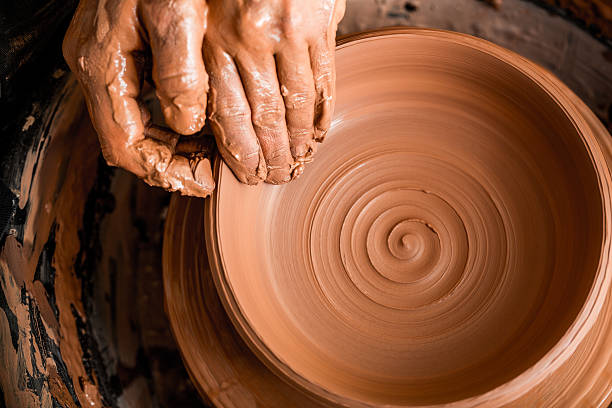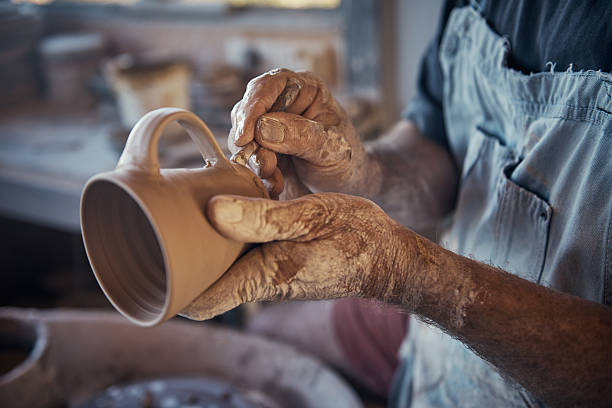People use the words pottery and ceramics interchangeably, but that’s not the right thing to do. Ceramics are a broader term that encompasses many types of non-metal clay objects that change form when fired.
Pottery, on the other hand, is a craft that involves making clay items for functional use. In this article, we will further define these crafts so you can understand their differences.

The Clay
Pottery and ceramics are both types of art that involve shaping clay into functional objects. The difference between the two crafts is in the type of pottery supplies used, the firing temperature, and other factors.
The first step in creating pottery involves mixing a raw material called clay with water to form a pliable material that can be formed into a desired shape. Clay can be made of a single kind of raw material or it can be mixed with other materials like sand, minerals and other additives. The resulting mixture is referred to as the clay body and it will determine what kinds of objects can be created with it.
For example, earthenware clay is comprised of selected types of clays that have been blended with feldspars and different proportions of other minerals. This creates a body that is primarily opaque but with a higher mechanical strength than bone china or porcelain. Earthenware also has a higher water absorption rate than porcelain, requiring it to be glazed to prevent it from being completely porous and unusable.
Another example is porcelain, which requires a very specific clay composition to ensure its translucency. The raw material used to make porcelain contains kaolin clay, which is a very fine white particle that has low organic content. Adding too much of this kind of clay to a porcelain recipe can lead to the formation of bubbles and other undesirable properties.
The Molding
The molding used in pottery and ceramics differs between the two craft types. Pottery typically uses a wheel-throwing technique for precise forms while ceramics use hand-building techniques like coiling and slab building to create more organic shapes. The materials used in ceramics are also different from those used in pottery. Ceramic clay, kaolin, silica, quartz and feldspar are some of the ingredients used in porcelain while earthenware clays, stoneware clays and raku clays contain more debris and impurities which may produce a coarser surface texture than other pottery clays.
Another way to tell whether an item is pottery or ceramics is by its weight and feel. Ceramics tend to be lighter than pottery and they have a much smoother texture due to the clay being refined to remove impurities during the molding process. On the other hand, pottery is a little heavier and has a less smooth surface which could be caused by the addition of things like sand and grog during the molding process.
When the clay is molded, it’s then fired at a temperature designed for that specific type of clay. This makes the clay extremely strong and hard to rip or tear. Next, the piece is glazed with special paints and underglazes. After glazing the piece, it’s again fired in a kiln which gives it its final strength and lustrous finish.

The Firing
When making pottery, it is important to know how the clay must be fired in order for the pieces to stick together and become hard. Depending on the firing technique, colors and patterns can also appear on the pots. For example, pit firing is a common method that involves burning combustibles in an open fire and then exposing the clay to the smoke vapor. This results in colored smoke stains that can remain on the pots.
Pottery typically has a lower firing temperature than ceramics. Usually, earthenware pots have to be fired at 1100 degrees or below in order for it to be stable and usable. Ceramics are generally more dense and harder, and they have a glass-like quality due to vitrification at higher temperatures.
In general, ceramics can be used in a more decorative manner than pottery. Ceramic dishes, for example, are a popular option for people looking to add a decorative touch to their kitchens. They can also be used to create decorative sculptures.
Although ceramics and pottery have a lot of similarities, it’s important to distinguish between the two crafts. While both are made from a non-metal material and require high heat to be formed into a hardened product, ceramics includes more sculptural pieces than pottery and has a broader range of uses. Pottery is still a part of the ceramics family, though, as it’s a specific form of the craft that creates vessels.
The Surface
Pottery and ceramics are two crafts that allow people to create one-of-a-kind products that express their personal style and inventiveness. They are used in a wide range of artistic and utilitarian applications, including decorative jars, tiles, and mosaics. They have been part of human culture throughout history, and they are a great way for individuals to express their creativity while learning and practicing complex procedures.
Potteries typically use clay, while ceramics can include other materials like glazes. It’s important to understand the difference between these two types of art so that you can choose the best one for your needs.
In pottery, the surface of a finished product may be left unglazed, which allows the natural colors and textures of the clay to show through. Ceramics, on the other hand, are often glazed, which gives them a shiny finish and allows for a variety of colors, patterns, and designs.
It’s also worth noting that pottery is a form of ceramics, while ceramics are more of a broader aspect of molding certain materials into either artistic or functional objects. This includes things like ceramics found in the aerospace industry, such as silica carbide and zirconium oxide; these are used to manufacture components for gas turbine engines and heat shields for spacecraft re-entry capsules. However, these types of ceramics are not considered pottery, because they don’t involve clay.